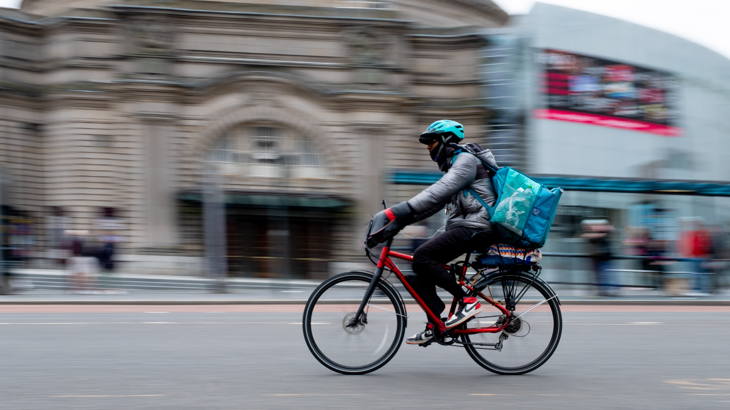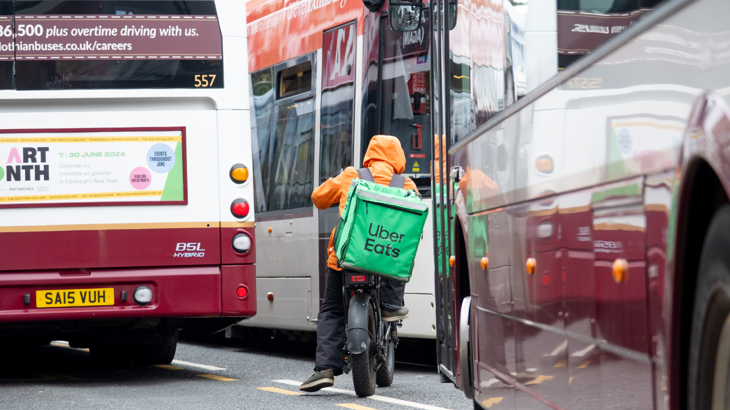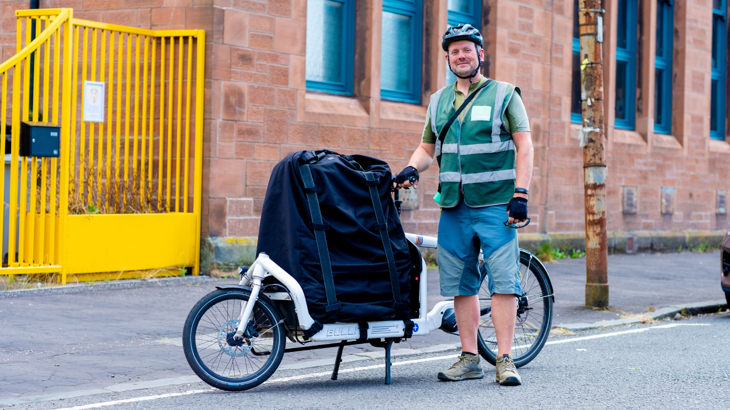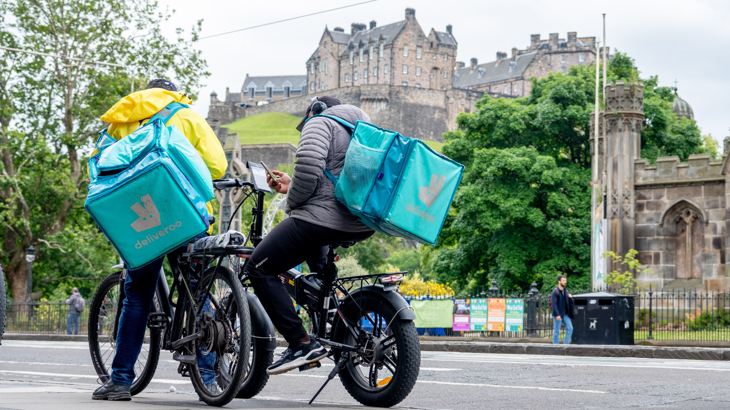In the first major study of its kind, our new report explores the experiences of delivery cyclists navigating Edinburgh and Glasgow. We delve into the challenges they face and the insights they offer for improving urban infrastructure.

Over recent years, there has been an increase in demand for delivery cyclists. However, delivery cyclists are currently not prominent in active travel research and infrastructure discussions. Credit: Michael Kelly/Sustrans
The emergence of food delivery platforms has led to an increased visibility of delivery cyclists in cities around the world.
Cycle couriers are nothing new – as soon as bicycles were invented in the 1860s, they were used by businesses to make deliveries.
Aside from the clear environmental benefits, cycles are a cheaper alternative to vans or cars, and couriers can fit into tighter parking spaces and cut through traffic, therefore saving time.
Yet despite their popularity, delivery cyclists remain a sorely underrepresented group in wider research.
This is despite the fact that they offer unique and valuable insights into how our infrastructure can be better for everyone.
The new workplace?
With companies like Amazon and FedEx expanding their fleets of cargo bikes in Edinburgh and Glasgow, this sustainable mode of delivery is here to stay.
Every day, and often late into the night, delivery couriers are cycling on main roads, side streets and paths to deliver our orders as quickly as possible; the city streets are their office.
Our new report, funded by Transport Scotland, reveals their experiences navigating roads, traffic and cycle paths in Edinburgh and Glasgow.
The interviewees, who represent both food and non-food delivery couriers, offered their views on a wide range of topics – from the dangers of cobblestone streets to the longing for closer connections with their fellow riders.

In the report, delivery cyclists saw their work as facilitating efficient and quick delivery for customers as well as being a non-polluting delivery mode. Credit: Michael Kelly/Sustrans.
Challenges on the road
Let’s start with their experiences using current travel infrastructure.
Delivery cyclists pointed to bumpy, poorly-maintained roads with poor drainage systems as challenges.
They also noted obstacles such as potholes, cobblestones, manholes and fallen leaves which make cycling feel unsafe.
According to respondents, cycle lanes were often blocked by parked cars and by lorries loading and offloading goods, meaning they either need to ride around them or dismount their cycle.
Interviewees also reported that cars repeatedly got too close to them, and that they were often cut off by cars turning left even though the cycle lane was clearly demarcated with a painted line.

Andrew Taylor, of Velo-City deliveries, highlighted the need for extra support and joined-up infrastructure. Credit: Michael Kelly/Sustrans.
Those with cargo bikes described the difficulties they had fitting their trailer into narrow cycle lanes, and how they found cobblestones on inclined streets to be “extremely dangerous".
Lastly, respondents said dropped kerbs, where the pavement dips for a short distance to the level of the road or cycle lane, allowed them to skip traffic, access houses for delivery and escape uncomfortable interactions with drivers.
In particular, those using cargo bikes said the absence of dropped kerbs presented challenges to them in doing their job.
Building a community
Interestingly, respondents also felt that the increase in the number of delivery cyclists over recent years made it difficult to have a real sense of community.
As the job involves independent working, riders suggested that designated hubs could provide a place to connect.

Respondents felt that the increase in the number of delivery cyclists made it difficult to have a real sense of community. Credit: Michael Kelly/Sustrans.
Interviewees generally felt that there was a mismatch between the way delivery cyclists viewed themselves and the way they were viewed by the public.
They highlighted that bike deliveries are faster and more efficient than car deliveries and contribute to “the mission of sustainable practices within the food industry”.
Recommendations
When asked what would make it easier to deliver by cycle, the removal of barriers, more cycle parking and clearer signage were found to be the top solutions.
The research found that most delivery cyclists agreed that better access to toilet facilities, more shade or shelter and more water fountains would make delivering by cycle at least a little more comfortable.
The delivery cyclists involved in the study suggested the following factors to make them feel safer, including:
- better-connected, wider cycle routes
- segregation from traffic with clear markings
- improved road maintenance
- stricter enforcement of speed limits and the highway code
- reduced volumes of traffic
- more ‘cycle-aware’ education for road users.
As businesses continue to invest in sustainable last-mile delivery, we hope these findings will support transport planners and others to plan for good quality infrastructure that meets the needs of delivery cyclists.
Download the ‘Delivery Cyclists: Insights into an overlooked demographic’ report.





